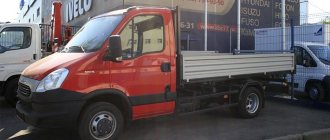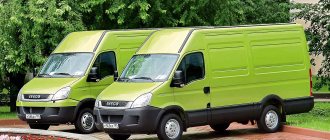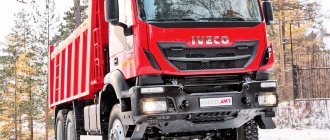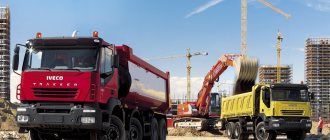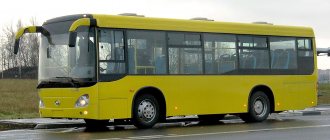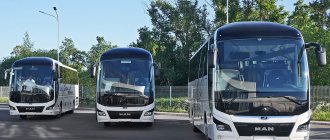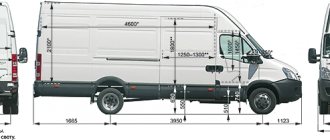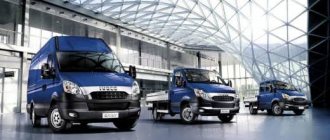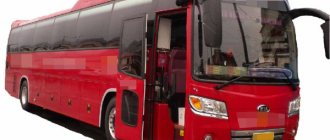Neman-4202: “rocket” bus from Belarus
Having moved from the status of an independent plant under the wing of MZKT, the Belarusian automobile assembly plant "Neman" has done significant work to improve products in order to increase their competitiveness. Let's get acquainted with a not very well-known bus in Russia, built on an extended Iveco Daily chassis.
Mikhail Ozherelev
Neman-420224-511-01 Overall length: 8.78 m Start of sales: 2019 Price: 4.5 million rubles.
This bus, just under nine meters long, is jokingly called “rocket bus.” And all because the Lida Buses Neman enterprise has been a branch of the Minsk Wheel Tractor Plant (Volat) since 2014, which is under the jurisdiction of the State Military-Industrial Committee of Belarus. By the way, Neman buses are now the most popular (in terms of the number of copies produced) MZKT product.
At the driver’s workplace, by today’s standards, everything is standard.
The Russian premiere of the new, third generation Neman-4202 took place at the Busworld Russia 2022 exhibition. Sales began in 2022. Currently, the line includes five modifications of the Neman-4202: urban, suburban, intercity, tourist and school. All of them belong to the middle class and are built on an extended Iveco Daily 70C17 chassis (wheelbase - 4350 mm), equipped with a 170-horsepower Iveco F1C Euro-5 engine, which is paired with a 6-speed manual gearbox ZF 6S 400. Rear suspension - pneumatic.
The floor level on the rear platform can be adjusted manually - there are special keys.
“Iveco-Neman” 2022 model year has an original design. Italian motifs are clearly visible in it. And it’s not just about the imported chassis: previously, bus builders from Lida worked closely with the Cacciamali Spa body shop. However, today we are dealing with a different product, to which Belarusian designers had a hand. In addition to the hood and wings, which became even longer (in comparison with the previous version), other elements of the front part were also modified - the windshield decreased in height, and the plastic roof, on the contrary, increased slightly. The glazing, as before, is panoramic, and the side windows in the driver’s area are heated. For better maintainability, the rear mask now has separate blocks of lights located in the most impact-prone places - previously they were made as a single element, and it was expensive to change them in the event of an accident. By the way, previously the company ordered a number of body elements from third-party suppliers, but now all fiberglass parts are manufactured in-house. As for the frame, it is welded from rectangular steel pipes. The lining of the sides and service hatches is made of aluminum. The bus doors are also made of “winged metal”.
The spacing of the passenger seats is not the same.
The handles on the backs act as handrails; they allow you to transport standing passengers.
We are dealing with a commuter version of the bus. Its index is 420224‑511‑01. This configuration is designed to carry 31 passengers, with seating for 29. Soft seats produced by the Polish company Intap are equipped with three-point seat belts, a folding armrest and handles on the backs (which act as handrails, they allow you to transport standing passengers, which will further increase profitability during urban transportation) . The backrests are tilt adjustable. Interestingly, the pitch of the chairs is not the same - according to our measurements, the length of the inter-row space varied from 69 to 90 cm, while there is no clear pattern in the placement of narrow and wide places, as if the chairs were arranged not according to the drawings, but according to the location. Whether this is serious or a trifle, let the carriers themselves decide, it’s our business to state...
There are spacious shelves for hand luggage above the passengers' heads. The total volume of luggage compartments on the right, left and rear is a modest 2 cubic meters. This, of course, is not enough for work on intercity routes, but quite enough for a city-suburb line.
The heating of the passenger area is combined - convectors are located along the sides, and two heaters are located in the storage area. An Eberspaecher autonomous heater is included in the engine cooling system circuit. Ventilation is natural, supply and exhaust, through the hatch in the roof.
There are spacious shelves for hand luggage above the passengers' heads.
The interior of the driver's workplace, migrated from the latest generation Iveco Dail, does not need any special comments. On the captain's bridge it's almost like in a passenger car. Is it possible that the placement of the ERA-GLONASS “panic button”, which is mandatory for buses, was implemented inaccurately. Everything related to body systems - lighting, heating, door controls - is located to the left of the driver. You can reach the keys without lifting your back from the back of the chair. The Isri driver's seat is equipped with an armrest and inflatable lumbar support. But the injury-proof steering column has only one adjustment - tilt.
A lockable box is provided for storing travel documents.
The list of options is extensive. Buses can be equipped with parking sensors, a rear view camera, USB connectors for charging mobile phones, as well as an Internet access point via Wi-Fi. At the client's request, it is possible to install a DVD system with two ceiling monitors, a microphone and additional space for the guide.
Since relatively recently, buses have been equipped with spare parts packed in a wooden box.
There is another interesting point related to the fact that MZKT had a hand in the Nemans. Since relatively recently, buses have been equipped with spare parts packed in a wooden box, the same as for multi-axle chassis. A kind of greeting to bus buyers from the manufacturer of rocket carriers. The box will certainly come in handy around the house.
All points for filling process fluids and daily monitoring are as accessible as possible.
The front suspension is independent torsion bar, with anti-roll bar. Rear - dependent pneumatic. Such a successful combination in terms of smoothness of ride is rare for middle-class buses. By the way, air is pumped into the suspension by a compact electric compressor mounted in a sealed container on the rear axle beam.
Rear suspension with air cylinders.
The acceleration dynamics of the tested bus seemed to me not just excellent, but even too fast. If we add here maneuverability, refined reactions to steering wheel turns, excellent brakes (disc mechanisms on all wheels) and a soft ride - you get a minibus driver's dream. And the presence of a sixth gear in the transmission will be appreciated by those who work on commuter routes. Average fuel consumption when driving on the highway, according to the on-board computer, is 13.5 l/100 km. The service interval is 20,000 km; the bus is no different from the Iveco Daily van in this parameter.
For now, Iveco-Neman buses remain exotic on our roads: a dozen cars are sold a month throughout Russia. However, management plans to increase sales. But competitors are also strong. The main one, of course, is the VSN-700, which does (see Autopark No. 7/2016). There are hundreds of such buses in Moscow alone. They began to appear in other regions of the Russian Federation. Another, no less serious competitor also comes from the Nizhny Novgorod region, although it is called in an imported manner - Foxbus 22501 from the city of Vorsma (for more information about this, see “Vehicle Park” No. 4/2015). The circulation of Foxbuses is smaller, but there are at least dozens of copies built.
In terms of design, they are all beautiful. This means that it will also be necessary to shine with the quality of workmanship, and MZKT is extremely strict with this. Of course, it will be necessary to “play” not only with quality, but also with price, and Belarusians also know how to do this.
- A cozy interior with comfortable seats, a well-organized driver's workplace.
- Small luggage compartment volume.
Technical characteristics Neman-420224-511-01
| Passenger capacity | 31 people |
| Number of seats | 29 |
| Curb weight | 4650 kg |
| Full mass | 7000 kg |
| Dimensions (length/width/height) | 8780/2550/3840 mm |
| Wheelbase | 4350 mm |
| Luggage compartment volume | 2 m3 |
| Engine | Iveco F1C, diesel, in-line, 4 cylinders, 3 l, 170 l. With. at 1900 min-1, 350 Nm at 2100 min-1 |
| Transmission | 6 manual gearbox |
| Suspension (front/rear) | independent torsion/dependent, pneumatic |
| Brakes | disk |
| Tire size | 225/75R16 |
| Factory warranty | 2 years unlimited mileage |
| Service mileage | 20,000 km |
| Competitors | "Nizhegorodets" VSN-700, Foxbus 22501 |
The editors recommend:
Why do piston rings stick and how to prevent it?
A traffic police officer searched my car: did he have the right to do so?
Russians may be left without foreign cars: Western automakers have stopped supplying cars to our country
A ship that was transporting cars to Russia was detained in France
Half of the car factories in Russia have closed
News Media2
Discussion Cancel
Tourist bus NEMAN 420224-511 based on IVECO DAILY
Specifications
| Gross vehicle weight – | 7850 kg |
| Weight of the equipped vehicle – | 5600 kg |
| Permissible axle loads (front/rear) | 2500/5350 kg. |
| Overall dimensions, mm: length/width/height – | 8730/2340/3000 mm |
| Wheelbase - | 4750 mm |
| Front wheel track – | 1725 mm |
| Rear wheel track – | 1660 mm |
| Front overhang length – | 1010 mm |
| Rear overhang length – | 2690 mm |
| Passenger capacity, (number of seats) persons – | 28 (29/30 + 1) |
| Maximum speed – | 90 km/h (limiter) |
Engine
- Engine (diesel) – IVECO F1C, R4, EURO-5
- Power – 170 hp (107 kW / 350 Nm)
- Volume – 3.0 l.
- Engine sump protection
- Fuel tank – 115 l.
- Heated fuel filter
- Control fuel consumption – 15.0 l./100 km
Electrical equipment
- 12V, increased power generator 140A
- Battery 110 Ah
- Emergency switch
- Digital tachograph
- Immobilizer
- Audio preparation (antenna, 1 speaker)
Clutch/Clutch drive
- Friction, dry, single-disc, hydraulically driven. External diameter: 11” (280 mm).
Transmission
- Gearbox FPT 2840.6, mechanical, synchronized, number of speeds 6+1
Suspension
- front – torsion bar independent, with anti-roll bar and hydraulic telescopic shock absorbers
- rear – air suspension with ECAS system , with anti-roll bar and hydraulic telescopic shock absorbers
Brake system:
the ESP9 hydraulic system with active sensors and new functions for even greater safety and disc brakes on all axles. ESP 9 system includes: ABS - Anti-lock braking system Prevents wheel locking when braking EDB - Electronic brake force distribution Distributes braking force between the front and rear wheels ASR - Traction control Controls the engine and brakes to prevent wheel slip MSR - Engine Brake Control Regulates speed and engine braking when the gas pedal is released ESP – Electronic Stabilization System Brakes each wheel individually and lowers engine speed when the vehicle loses stability HBA – Hydraulic Brake Assist Increases pressure in the brake system during emergency braking Hill Holder – Hill Start Assist System Activates the brakes to hold the vehicle when starting off on a hill LAC – Adaptive Vehicle Weight Assist Recognizes longitudinal load distribution TSM – Trailer Sway Mitigation System Detects the presence of a trailer and adapts the ESP system accordingly HRB – Hydraulic system for increased braking force on the rear wheels Increases braking force on the rear axle during emergency braking HFC – Brake Compensation System Detects and compensates for reduced brake efficiency RMI&ROM – Roll Over Monitoring and Prevention System Prevents the vehicle from rolling over in an emergency
Frame:
- The bus chassis has an independent frame. The body frame is attached to the chassis frame on special pads. Spars - steel channel, tubular cross members. Spar dimensions: width 69 mm, height 184 mm, thickness 5 mm.
Wheels/Tires:
- Steel wheels, 225/75 R16, including spare wheel
Steering:
- with hydraulic booster, safety steering column
Additional equipment:
- First aid kit, warning triangle, portable flashlight, wheel chocks (2 pcs.), preparation for a fire extinguisher (bracket). Crankcase ventilation breather valve. Hammers. Fuel tank cap with lock, front and rear mudguards. Interior handrails. Buttons for requesting a stop and communication with the driver.
Guarantee
Factory warranty provided:
- 1st year for the entire assembled vehicle without mileage limitation
- 2nd year on the power line (engine, fuel injection system, transmission, transmission shaft, axles) with a mileage of no more than 200,000 km;
- Maintenance is carried out every 20,000 km
Technical characteristics of the Neman 4202 bus
The model is intended for urban transportation, but its body is lined with steel sheet. This allows you to use transport for longer routes. The cabin accommodates 23 seats, and there are two doors for entry and exit. The total passenger capacity reaches 35 people. The passages are made wide and handrails are provided.
The bus is equipped with a Yuchai turbodiesel engine (Euro 3) and a five-speed manual transmission. The engine power is 115 hp, and fuel consumption per 100 km reaches 15 liters. diesel or 25 l. gasoline. The maximum speed that a bus can reach is defined as 70 km/h.

